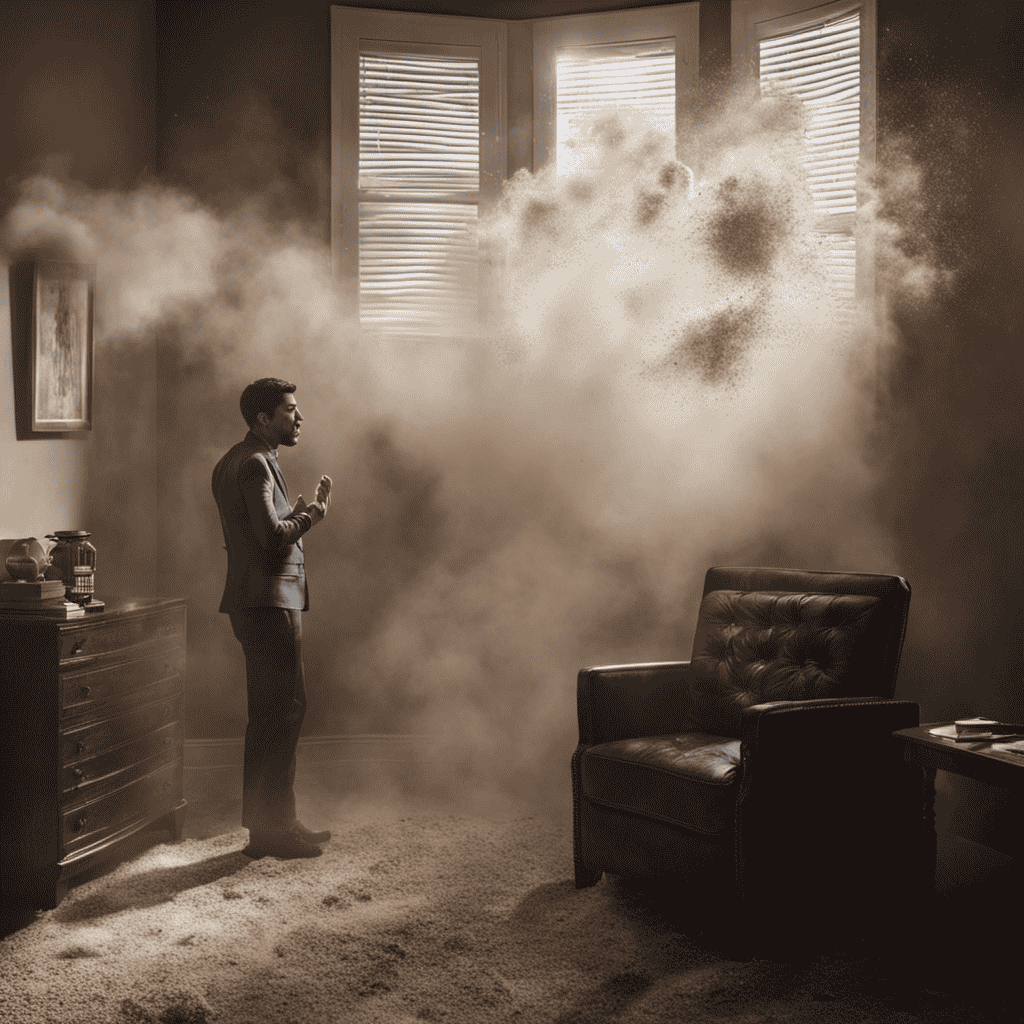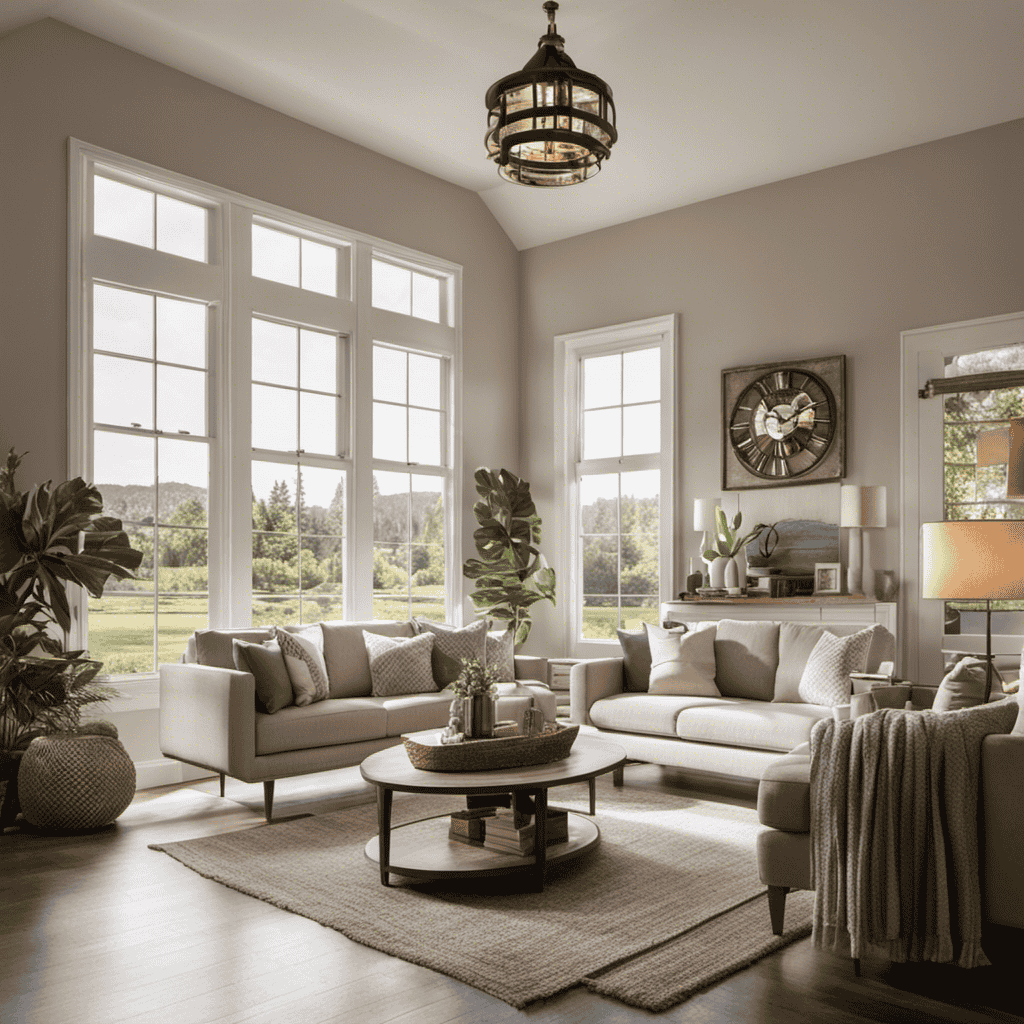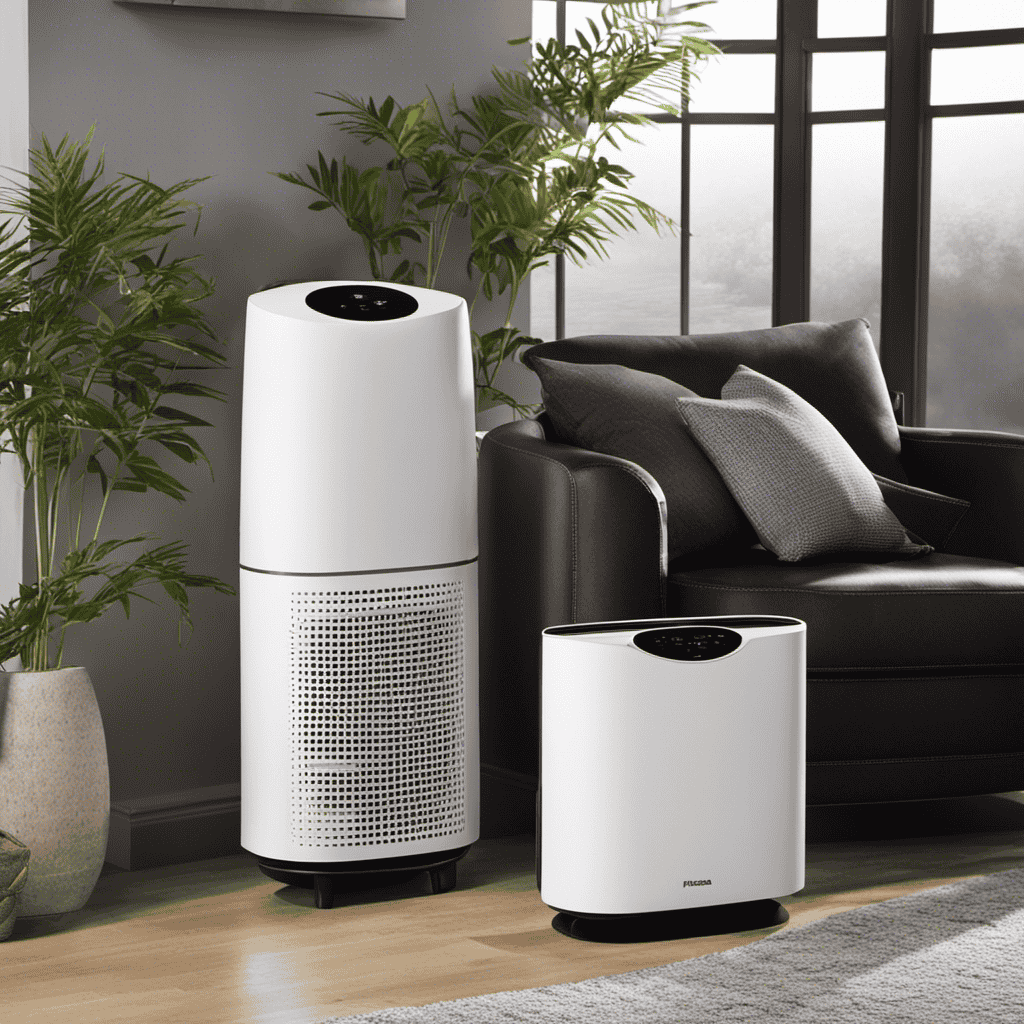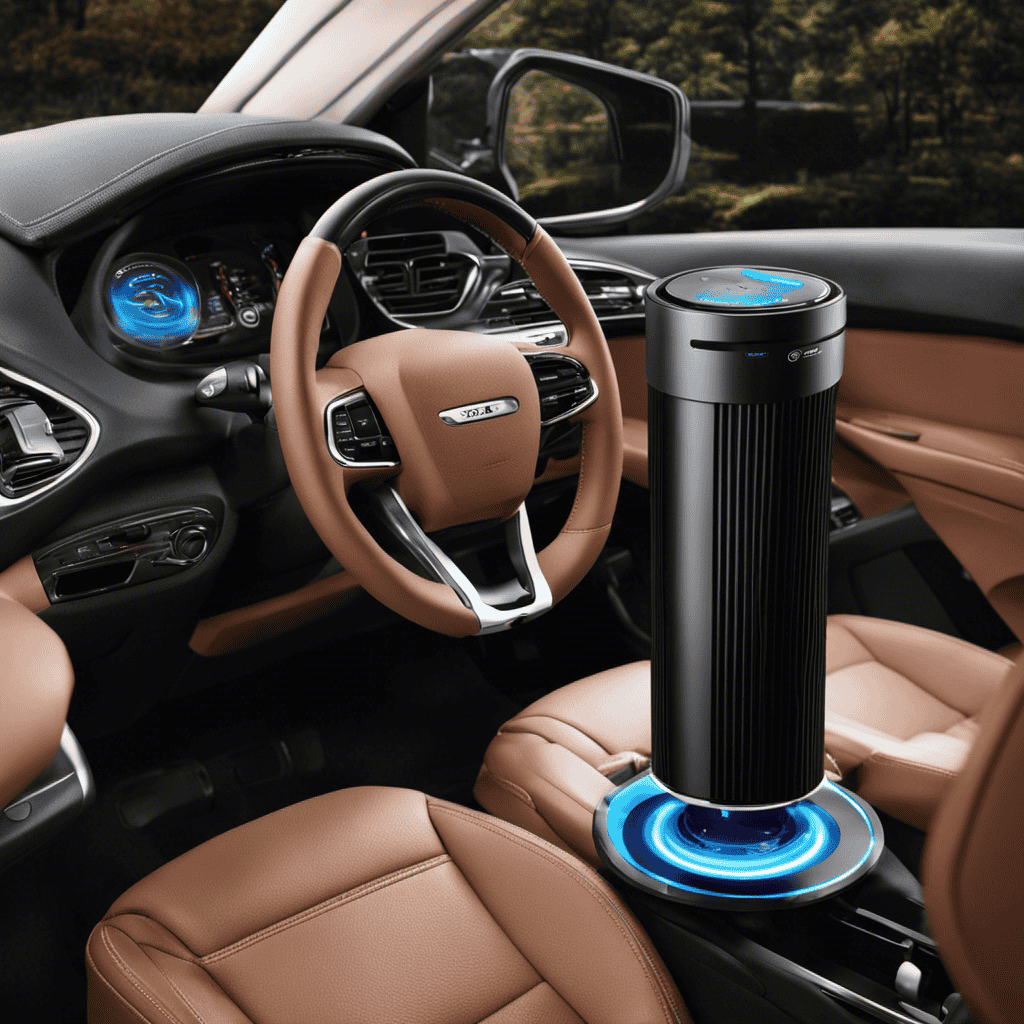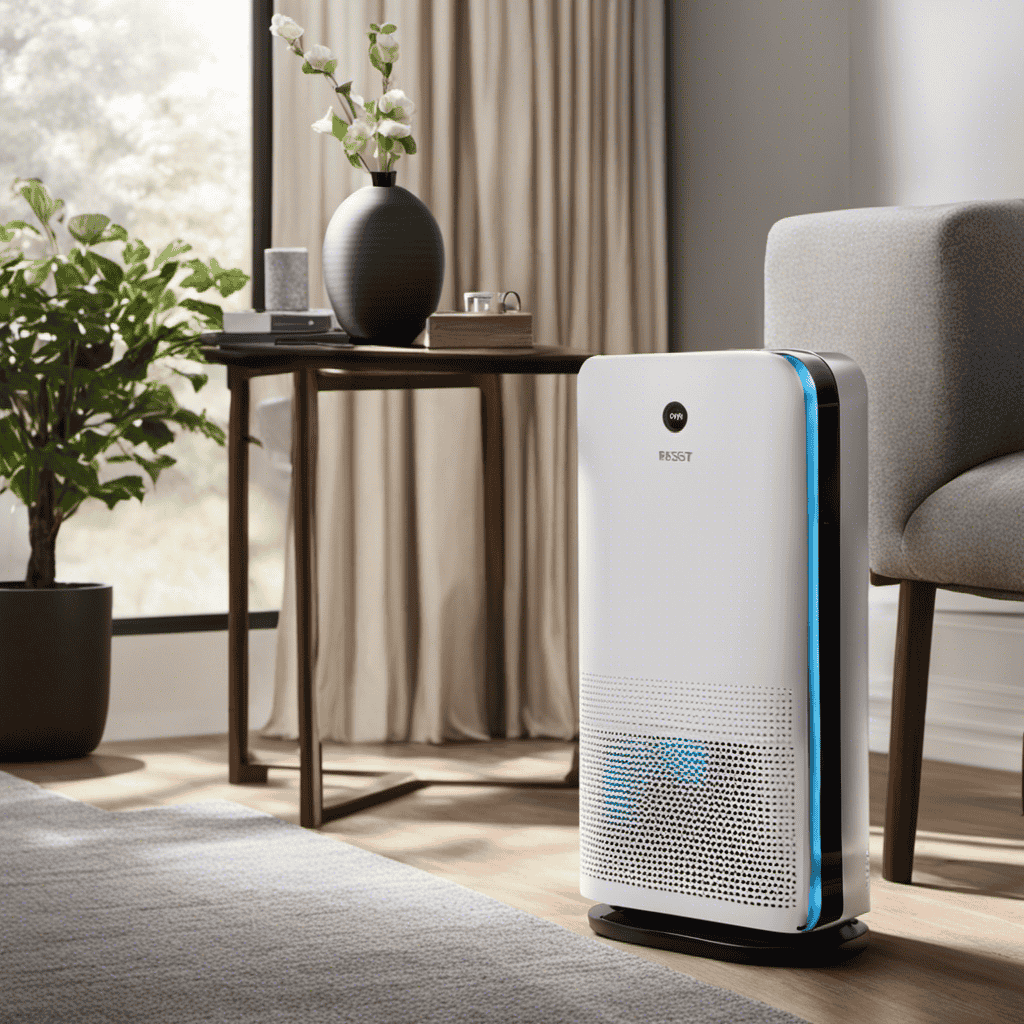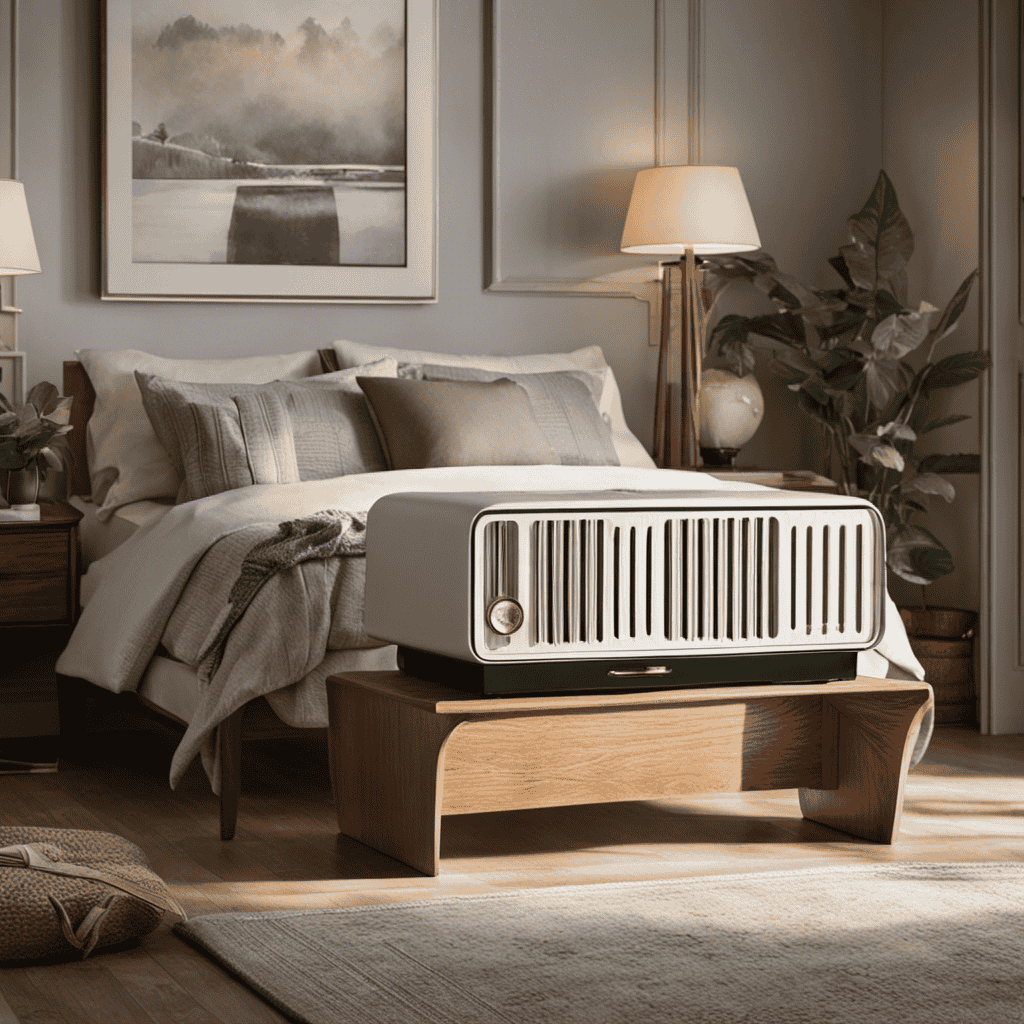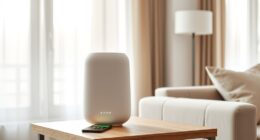I understand your frustration – why isn’t my air purifier functioning properly? Despite your efforts, it seems to be ineffective. But don’t worry! In this article, I will help you address common problems with air purifiers and offer a troubleshooting guide to help you get your purifier working again.
We’ll also delve into understanding error codes, offer tips for maintaining peak performance, and highlight common mistakes that can affect functionality.
Stay tuned to learn how to properly clean and maintain your air purifier, and when it’s time to consider a replacement.
Key Takeaways
- Regular filter cleaning or replacement is necessary for optimal performance
- Realistic expectations and sufficient time are important for air purifier to work effectively
- Troubleshoot common problems to improve purifier’s effectiveness
- Avoiding air purifier misuse and common mistakes is crucial for optimal performance
Common Issues With Air Purifiers
If your air purifier won’t work, one of the common issues could be a clogged filter. Troubleshooting techniques can help identify and resolve these problems.
Many people have misconceptions about air purifiers, which can lead to confusion when troubleshooting. One such misconception is that air purifiers are maintenance-free. In reality, regular filter cleaning or replacement is necessary to ensure optimal performance.
Another common misconception is that air purifiers instantly improve air quality. While they can effectively remove pollutants, it takes time for them to circulate and purify the air in a room. It’s important to have realistic expectations and give the air purifier sufficient time to work.
Troubleshooting Guide for Air Purifier Problems
Check out the troubleshooting guide to fix any issues you may be experiencing with your air purifier.
If your air purifier is not working, there are a few common problems that you can troubleshoot to improve its effectiveness.
First, check if the power cord is securely plugged into the outlet. Sometimes, a loose connection can cause the purifier to stop working.
Next, inspect the air filter for any clogs or buildup of dust and debris. A dirty filter can reduce the purifier’s efficiency.
Additionally, ensure that the purifier is placed in a suitable location with proper airflow.
Finally, check the settings and make sure they are adjusted correctly for your specific needs.
Understanding Air Purifier Error Codes
Understanding the meaning of air purifier error codes can help troubleshoot any issues you may encounter. When your air purifier displays an error code, it is trying to communicate a specific problem that needs to be addressed. Here are three common error codes and their interpretations:
-
E1: This code indicates a filter replacement is needed. Replace the filter according to the manufacturer’s instructions.
-
E2: This code suggests a sensor malfunction. Try cleaning the sensor or contacting customer support for further assistance.
-
E3: This code signifies a motor or fan issue. Check for any obstructions and ensure the motor and fan are functioning properly.
By understanding these error codes, you can take appropriate action to resolve the problem and get your air purifier working efficiently again.
Now, let’s move on to the next section, where I will provide you with some valuable tips for maintaining your air purifier’s performance.
Tips for Maintaining Your Air Purifier’s Performance
When it comes to maintaining optimal performance for your air purifier, there are three key points to consider.
Firstly, cleaning the air filters regularly is essential to ensure that they are free from dust and debris.
Secondly, it is important to replace the filters as needed to maintain the effectiveness of the purifier.
Lastly, avoiding misuse of the air purifier, such as running it continuously at high speeds, can help prolong its lifespan and prevent unnecessary wear and tear.
Cleaning Air Filters Regularly
To keep your air purifier working effectively, make sure you’re regularly cleaning the air filters. Cleaning the air filters is essential for maintaining the performance and efficiency of your air purifier. There are several cleaning techniques that you can employ to ensure that your air filters are free from dirt, dust, and other contaminants.
Regular maintenance of your air filters offers numerous benefits, including:
-
Improved Air Quality: Regularly cleaning the air filters removes allergens, dust particles, and pollutants, resulting in cleaner and healthier air for you to breathe.
-
Increased Lifespan of the Air Purifier: By regularly cleaning the air filters, you prevent them from becoming clogged and overloaded, which can lead to the air purifier working harder and potentially breaking down prematurely.
-
Energy Efficiency: Clean air filters allow the air purifier to operate more efficiently, reducing the energy consumption and saving you money on your electricity bills.
Replacing Filters as Needed
Regularly replacing filters is essential for ensuring the continued efficiency and effectiveness of your air purifier. Over time, filters can become clogged with dust, allergens, and other particles, which can hinder the purifier’s ability to effectively clean the air. By replacing the filters as needed, you can maintain optimal performance and ensure that your air purifier is working at its best.
Here are some signs that your filters may be clogged and in need of replacement:
| Signs of Clogged Filters |
|---|
| Reduced airflow |
| Increased noise level |
| Decreased air purifying effectiveness |
Regular maintenance of your air purifier, including replacing filters, is crucial to maintain clean and healthy air in your home. By following the manufacturer’s guidelines and performing regular filter replacements, you can extend the lifespan of your purifier and maximize its efficiency.
Transitioning into the next section about avoiding air purifier misuse, it is important to note that proper usage and maintenance go hand in hand to ensure the longevity and effectiveness of your air purifier.
Avoiding Air Purifier Misuse
Using your air purifier correctly is essential to maximize its performance and ensure clean and healthy air in your home. To avoid air purifier misuse, here are some important guidelines to follow:
-
Proper air purifier placement:
-
Place the unit in a central location to maximize air circulation.
-
Keep it away from walls and furniture to allow for proper airflow.
-
Avoid placing it near sources of heat or moisture, such as stoves or bathrooms.
-
Benefits of using an air purifier:
-
Removes airborne particles like dust, pollen, and pet dander, improving indoor air quality.
-
Reduces the risk of respiratory issues and allergies.
-
Eliminates odors and harmful gases, creating a fresh and clean environment.
Common Mistakes That Affect Air Purifier Functionality
One common mistake that can affect your air purifier’s functionality is not regularly changing the filters. Filters play a crucial role in trapping and removing airborne particles, such as dust, pollen, and pet dander. Over time, these particles accumulate and clog the filters, reducing their efficiency and airflow. It is recommended to check and replace the filters according to the manufacturer’s instructions to ensure optimal performance. Additionally, choosing the right air purifier for your needs is essential to avoid potential noise issues. Different models have varying noise levels, measured in decibels (dB). Consider factors such as room size, noise tolerance, and specific air purification requirements when selecting an air purifier. Here is a table comparing different air purifiers based on noise levels:
| Air Purifier Model | Noise Level (dB) |
|---|---|
| Model A | 40 dB |
| Model B | 50 dB |
| Model C | 35 dB |
| Model D | 45 dB |
How to Properly Clean and Maintain Your Air Purifier
To properly clean and maintain your air purifier, start by unplugging it from the power source. Cleaning your air purifier regularly is crucial for its proper functionality and to ensure that it continues to provide you with clean and fresh air.
Here are some key steps to follow for effective air purifier maintenance:
-
Remove and clean the filters: Check the manufacturer’s instructions on how often you should clean or replace the filters. Cleaning the filters regularly will help to remove dust, pollen, and other particles from the air.
-
Wipe down the exterior: Use a soft cloth or sponge dampened with mild soap and water to clean the exterior of the air purifier. Make sure to remove any dirt or debris that may have accumulated.
-
Clean the vents and grilles: Use a vacuum cleaner with a brush attachment to remove any dust or dirt from the vents and grilles of the air purifier.
Proper maintenance of your air purifier not only ensures its longevity but also maximizes its performance, providing you with the many benefits of using an air purifier.
When to Consider Replacing Your Air Purifier
As an expert in air purifiers, I have encountered many cases where users were unsure whether their purifier was malfunctioning.
There are several signs to look out for, such as decreased airflow, unusual noises, or a persistent odor.
Additionally, understanding the longevity of air purifiers is crucial in determining when it’s time to replace them, as most purifiers have a lifespan of around 5-10 years depending on usage and maintenance.
Signs of Malfunctioning Purifier
If your air purifier isn’t working, you might notice strange smells or increased allergy symptoms. It’s important to troubleshoot the issue promptly to ensure clean and healthy air in your home.
Here are some signs that your air purifier may be malfunctioning:
-
Purifier Noises: Unusual noises such as grinding, rattling, or buzzing can indicate a problem with the fan or motor. These noises should be investigated to prevent further damage.
-
Signs of Clogged Air Filters: A clogged air filter can hinder the purifier’s performance. Look for signs such as reduced air flow, excessive dust accumulation on the filter, or a strong odor coming from the machine.
-
Decreased Efficiency: If you notice that your air purifier is not effectively removing allergens or odors from the air, it may be a sign of malfunction. Regular maintenance and cleaning can help improve the efficiency of your purifier.
Longevity of Air Purifiers
To ensure your air purifier lasts for a long time, regular maintenance and cleaning are essential. Proper care and upkeep not only prolong the lifespan of your air purifier but also ensure optimal performance and clean air quality. Regular maintenance includes changing the filters, cleaning the exterior and interior components, and checking for any signs of wear or damage. By following these maintenance practices, you can enjoy the benefits of a well-functioning air purifier for years to come. Here is a table highlighting the benefits of regular maintenance:
| Benefits of Regular Maintenance |
|---|
| 1. Improved air quality |
| 2. Increased energy efficiency |
| 3. Extends lifespan |
| 4. Reduces allergens and odors |
| 5. Cost-effective solution |
Taking the time to maintain your air purifier is a small investment that yields significant returns in terms of clean and healthy air in your home or workspace.
Frequently Asked Questions
Are All Air Purifiers Suitable for All Room Sizes?
No, not all air purifiers are suitable for all room sizes. Room size compatibility is an important factor to consider when choosing an air purifier, especially for larger rooms where effectiveness may vary.
Can Air Purifiers Remove All Types of Pollutants, Including Gases and Odors?
Air purifiers are designed to remove various pollutants, including gases and odors. However, it’s important to note that their efficiency can be affected by factors such as maintenance and common misconceptions about air purifiers.
How Long Does It Typically Take for an Air Purifier to Improve Indoor Air Quality?
Typically, the speed at which an air purifier improves indoor air quality depends on factors such as room size, pollutant levels, and the efficiency of the purifier. Regular maintenance, like cleaning filters, ensures optimal performance for better air quality.
Can Air Purifiers Help to Alleviate Allergies and Respiratory Issues?
Air purifiers can greatly alleviate allergies and respiratory issues by removing airborne allergens like dust and pet dander. They also contribute to better sleep quality by creating a cleaner and healthier indoor environment.
Are There Any Health Risks Associated With Using an Air Purifier?
Using an air purifier has numerous benefits, such as reducing allergens and improving air quality. However, there are common misconceptions about safety risks. It’s crucial to educate oneself and follow proper usage guidelines to ensure optimal health and well-being.
Conclusion
After going through the troubleshooting guide and understanding the error codes, I was able to fix my air purifier and restore its functionality.
It was like a breath of fresh air when I finally saw it working again, like a gentle breeze sweeping away all the impurities in the room.
I learned the importance of regular maintenance and avoiding common mistakes that can hinder its performance.
Now, with a properly cleaned and maintained air purifier, I can confidently breathe in clean and pure air.
